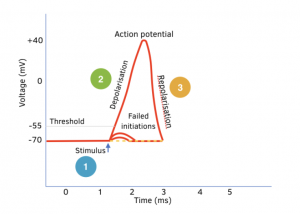Depolarisation and Repolarisation in the Action Potential (A-level Biology)
Depolarisation and Repolarisation in the Action Potential
Generating an Action Potential
Depolarisation and Repolarisation
- Stimulus – A stimulus triggers an inflow of Na+ ions into the cell. This increases the potential difference from -70mv to a less negative value. During this period, there are some failed initiations of the action potential.
- Depolarisation – The threshold potential (-55mV) is reached, and voltage-gated Na+ ions open. Therefore Naᐩ ions rapidly diffuse in. The potential difference increases to +40mV, meaning the inside of the cell is more positive than the outside.
- Repolarisation – Voltage-gated potassium channels open and sodium channels close. Kᐩ ions quickly diffuse out of the axon, repolarising the membrane.

An action potential is a brief electrical impulse that travels down the axon of a neuron. It is essential for transmitting signals between neurons, and is a key concept in A-level Biology.
Depolarisation is the process by which the membrane potential of a neuron becomes less negative, leading to an action potential. This is caused by the influx of positively charged ions, such as sodium ions, into the cell.
Repolarisation is the process by which the membrane potential of a neuron returns to its resting state after an action potential. This is caused by the efflux of positively charged ions, such as potassium ions, out of the cell.
Voltage-gated ion channels are integral membrane proteins that open or close in response to changes in membrane potential. They play a critical role in depolarisation and repolarisation by allowing ions to flow in or out of the cell, creating and terminating the action potential.
An action potential is initiated when the membrane potential of a neuron reaches a certain threshold level. This triggers the opening of voltage-gated sodium channels, leading to the influx of sodium ions and depolarisation of the membrane.
The refractory period is a brief period of time after an action potential during which the neuron is less responsive to additional stimuli. This is due to the inactivation of sodium channels and the slow repolarisation of the membrane.
Saltatory conduction is the process by which action potentials are conducted along myelinated axons. The myelin sheath insulates the axon, allowing the action potential to jump from node to node, increasing the speed of transmission.
The size of the action potential is directly proportional to the strength of the signal being transmitted. This is because a stronger stimulus will cause more ion channels to open, resulting in a larger influx of ions and a larger depolarisation.
Neurotransmitters are chemical messengers that are released by neurons and bind to receptors on the next neuron in the pathway. This allows for the transmission of the signal across the synapse, and is a critical part of the neural communication process.
Drugs and toxins can affect the action potential by altering the function of ion channels or neurotransmitter receptors. This can lead to changes in the strength or duration of the action potential, and can have a wide range of effects on neural function and behavior.





Still got a question? Leave a comment
Leave a comment